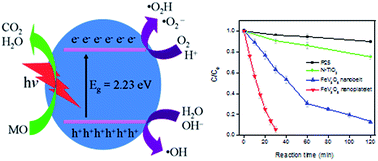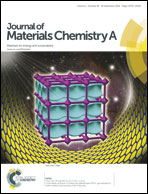pH-controlled growth of ultrathin iron vanadium oxide (FeV3O8) nanoplatelets with high visible-light photo-catalytic activity†
Abstract
The development of highly efficient visible-light photocatalysts is of great significance in the area of environmental decontamination and energy conversion. Especially, photocatalysts with ultrathin two-dimensional nanostructures have attracted tremendous attention because of their unique quantum size and surface effects. Here, we prepare for the first time the quasi-two-dimensional ultrathin iron vanadium oxide (FeV3O8) nanoplatelets with a thickness of only 2.75 nm by a pH-controlled hydrothermal reaction. The Brunauer–Emmett–Teller (BET) surface area of the FeV3O8 nanoplatelet is measured to be 162.35 m2 g−1, which is about 3.2-fold higher than that of commercial P25, and is significantly higher than those reported for vanadates with similar structures. Importantly, these ultrathin nanoplatelets demonstrate good stability under visible-light irradiation (λ ≥ 400 nm), highly efficient recycling utilization, and superior photo-catalytic activity as compared with conventional photocatalysts and structurally similar vanadates, holding significant potential for further applications in environmental decontamination.


 Please wait while we load your content...
Please wait while we load your content...